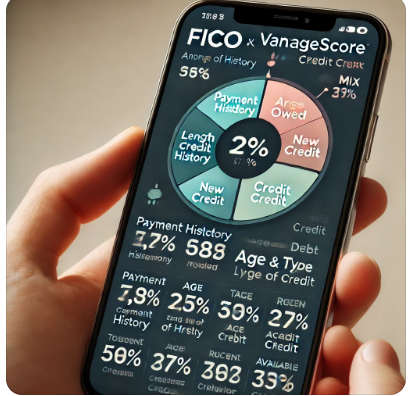Credit Score Breakdown: FICO and Vantage Scores
Credit scores are essential tools for assessing an individual’s creditworthiness. Two of the most widely used scoring models are FICO and Vantage Scores. Understanding the nuances between these models is crucial for managing and optimizing your credit health. Here’s a comprehensive breakdown of what consumers need to know about these credit scores.
FICO Score Overview
FICO, developed by the Fair Isaac Corporation, has been a cornerstone in credit scoring since 1989. The scores range from 300 to 850, with higher scores indicating better creditworthiness. The FICO score is derived from five key factors:
- Payment History (35%): This is the most significant factor, reflecting the punctuality of your credit account payments.
- Amounts Owed (30%): This includes the total amount of debt and the percentage of available credit being used (credit utilization).
- Length of Credit History (15%): A longer credit history improves your score, providing more information about your financial behavior.
- New Credit (10%): This factor considers recent credit inquiries and the number of new accounts opened.
- Credit Mix (10%): A diverse mix of credit accounts (credit cards, mortgages, installment loans) can positively impact your score
VantageScore Overview
VantageScore, a model developed in 2006 by the three major credit bureaus (Equifax, Experian, and TransUnion), also uses a 300 to 850 scale. However, it differs from FICO in several aspects, particularly in how it weighs different factors:
- Payment History (40%): Like FICO, this is the most critical factor, heavily influencing the score.
- Credit Utilization (20%): This considers the percentage of available credit used.
- Credit Age and Type (21%): The length and diversity of credit accounts play a significant role.
- Total Balances and Debt (11%): This considers the total amount owed across all accounts.
- Recent Credit Behavior and Inquiries (5%): This includes recent credit applications and inquiries.
- Available Credit (3%): The amount of available credit also has a minor influence
Key Differences Between FICO and VantageScore
- Data Usage: VantageScore can score individuals with a shorter credit history—often after just one month of account activity. In contrast, FICO requires at least six months of history and recent account activity.
- Treatment of Credit Inquiries: Both models reduce the impact of multiple inquiries when shopping for loans. FICO typically groups inquiries within 45 days as a single inquiry, while VantageScore uses a 14-day window.
- Inclusion of Trended Data: VantageScore 4.0 incorporates trended data, considering changes in credit behaviors over time. This approach offers a more dynamic view of a consumer’s credit use. On the other hand, FICO evaluates credit behavior at a single point.
Which Score Do Lenders Use?
While FICO remains the most widely used by lenders, especially in mortgage lending, VantageScore has gained traction, particularly for consumer access to credit scores through free services. Both scores offer valuable insights into a consumer’s credit health, but the choice of model can vary depending on the lender and type of credit being sought.
Conclusion
Understanding the nuances between FICO and VantageScore can help consumers better navigate their financial lives. Both scores provide a valuable assessment of creditworthiness, but they use slightly different methods and weightings. By staying informed and focusing on the factors that most influence these scores, consumers can work towards maintaining a healthy credit profile.
For more detailed information, consumers are encouraged to check their credit reports regularly and use free tools available through various financial services.

Pingback: The Federal Reserve’s Upcoming Rate Cut: A Game-Changer for Car Buyers - FMC
Pingback: How to Deal with a Sudden Big Drop in Your Credit Score: A Step-by-Step Guide - FMC
Pingback: How Your FICO Score Is Affected by Your Credit Age - FMC
Pingback: How to Remove Late Payments from Your Credit Report: Practical Steps to Reclaim Your Score - FMC
Pingback: Why Credit Scores Are Dropping Across America - FMC